Exploring Indigenous Heritage and Culture through Passport Places
Indigenous peoples have lived on the land that is now Canada since time immemorial, and today there are about 1.8 million Indigenous people living in Canada.
While stone tools, middens (usually consisting of animal bones and remains after hunting or cooking), and other pieces of archaeological evidence can provide context and information about the history of Indigenous people, there is also plenty to learn from Indigenous people who are living today. Indigenous cultures and traditions have continued into the present-day, and multiple historic sites across Canada honour the history of the land and the people, as well as honouring the present and looking toward the future. These Passport Places explore Indigenous heritage, culture and traditions through art, exhibitions, archaeology, and the land itself. From some of the earliest contact between Indigenous peoples and Europeans, to Indigenous poets and immersive cultural experiences, these places welcome you.
National Trust headquarters are on traditional territory of Algonquin Anishnaabe. This place was used historically by several Indigenous peoples and is home today to First Nations, Metis and Inuit people. The National Trust is active on the traditional territories of many Indigenous people across the land now known as Canada. In this article we look at the legacies and on-going contributions of some of these peoples. If you’d like to learn which traditional territory you reside on, you can do so using Native Land Digital.
Beothuk Interpretation Centre, Boyd’s Cove, NL
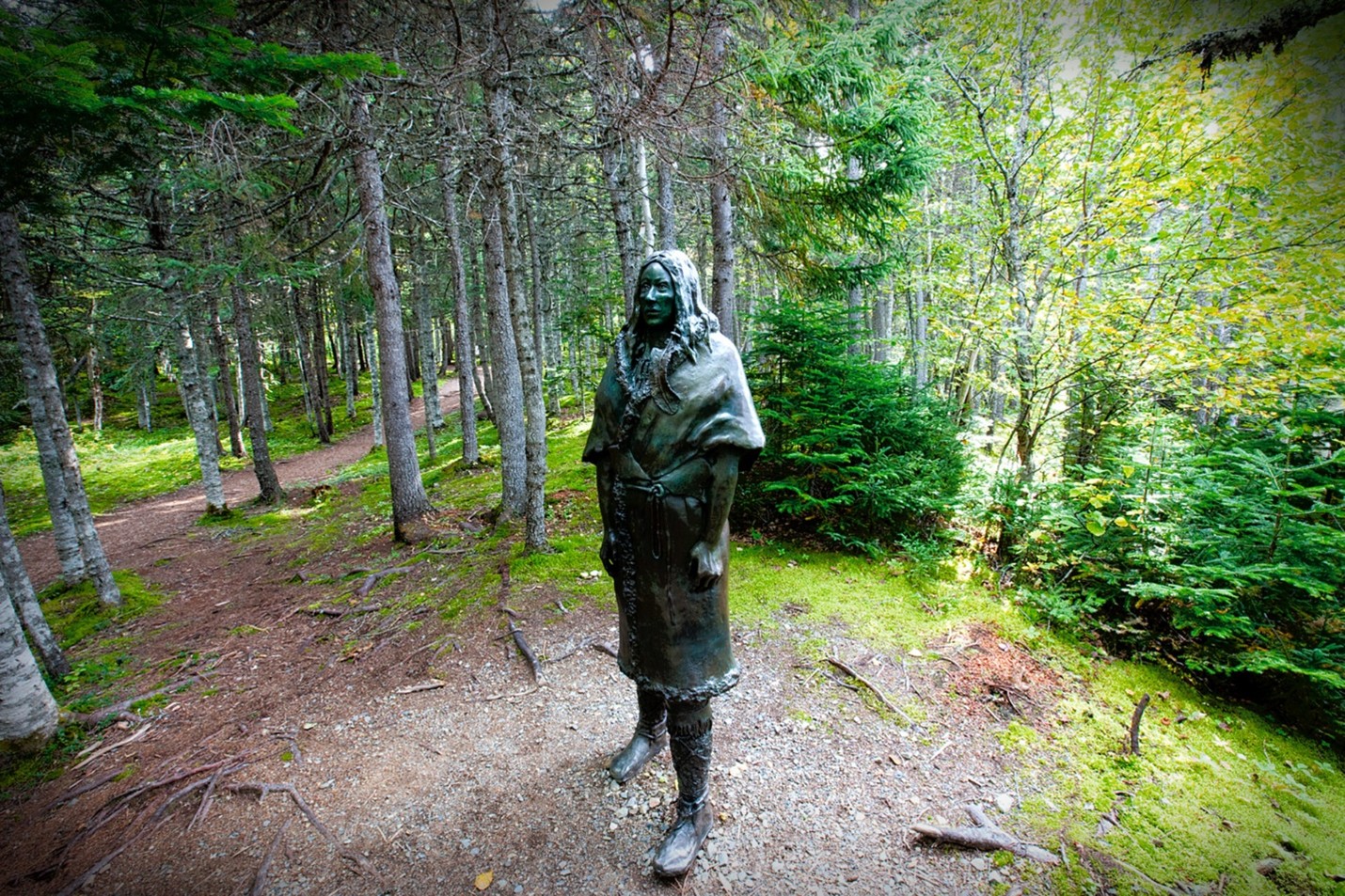
The Spirit of the Beothuk depicts Shanawdithit, believed to be the last Beothuk, and was designed by renowned Newfoundland sculptor Gerald Squires. Photo courtesy of Provincial Historic Sites
Three hundred years ago, the current site of the Beothuk Interpretation centre was a Beothuk village. Today, the Beothuk Interpretation Centre’s exhibits and artifacts depict and foster an appreciation for the now vanished Beothuk culture.
The Beothuk were a group of Indigenous people who lived on the island of Newfoundland in Atlantic Canada. The Beothuk culture dates back to around AD 1500, and is the most recent cultural manifestation of peoples who first migrated from Labrador to present-day Newfoundland around two thousand years ago. In fact, Norse explorer Leif Erikson may have encountered ancestors of the Beothuk, known as the Dorset culture. Contact with European settlers usually resulted in a negative outcome for one side, with a few exceptions such as John Guy’s 1612 party that shared a meal and exchanged gifts with a group of Beothuk on November 6, 1612. Loss of food sources from competition with Europeans, infectious disease, and violent encounters with trappers and settlers resulted in the disappearance of the Beothuk culture, though oral histories maintain that the Beothuk intermarried with other Indigenous groups as they moved inland.
The Beothuk Interpretation Centre honours this vanished culture with a walking trail to the Beothuk village site, where the outline of housepits remain as the only visible evidence of the Beothuk who once lived here. Along the trail, a sculpture by a renowned Newfoundland artist depicts , who is believed to have been the last of the Beothuk and died of tuberculosis in 1829. Her drawings depict interactions with European settlers and played a vital role in the present-day understanding of Beothuk culture and people.
Visitors can join an interpreter for an introduction to the site, or explore on their own, view the archaeological site, picnic on the site, and walk the wooded trail. Visitors to the site are invited to pay respect to the memory of the Beothuk people and leave an offering at the Spirit Garden. A selection of natural materials is available at the Interpretation Centre to make your offering.
Chiefswood National Historic Site, Ohsweken, ON
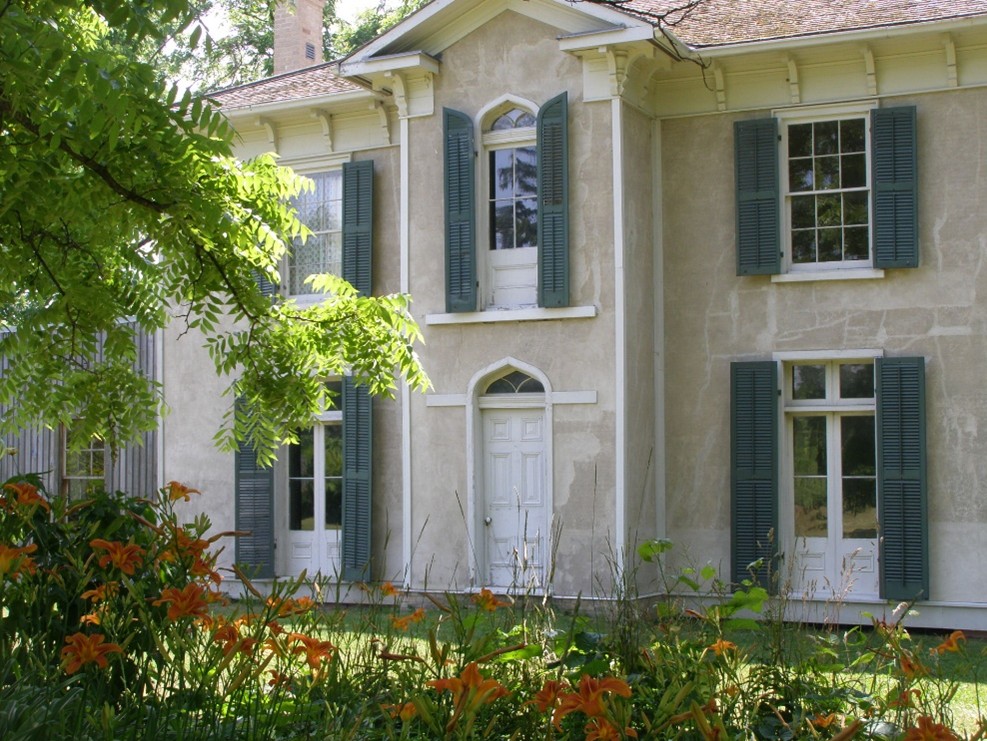
Photo courtesy of Chiefswood National Historic Site
Chiefswood National Historic Site was gifted by George Henry Martin Johnson, a hereditary Chief on the Haudenosaunee Confederacy Council and an Interpreter for churches and the government, to his wife, the English-born Emily Susanna (Howells) Johnson. Their interracial marriage occurred in opposition to both Emily and George’s families, and Reverend Elliot, Emily’s brother-in-law, refused to perform the marriage. The couple, determined to wed, found another priest who would. George began construction on the house in 1853, the same year the couple was wed, using walnut milled from trees on the grounds. It reportedly took three tons of nails to build Chiefswood.
Emily and George taught their four children, Henry, Helen, Allen and Emily Pauline, to embrace both their Mohawk and English heritage. Emily Pauline, also known as Tekahionwake, was enthralled by the natural environment of the Chiefswood estate and channeled this inspiration into poetry beginning at the age of 10, making her first public appearance in 1892. She is known as one of North America’s most notable entertainers of the late 19th century and has been celebrated widely since the end of the 20th century.
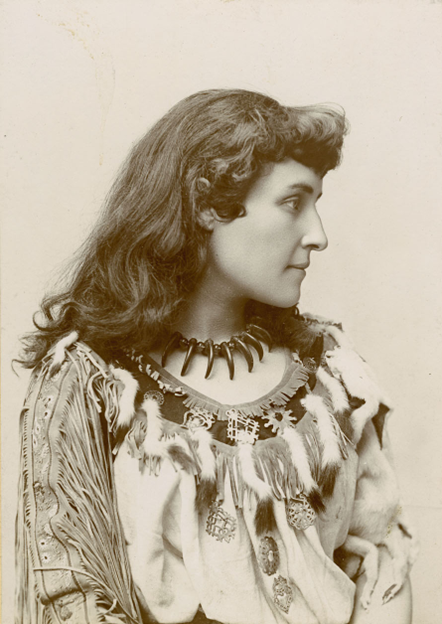
Emily Pauline Johnson, c. 1885-95. Library and Archives of Canada.
Today, Chiefswood has been restored to reflect what the house would have looked like when the Johnsons lived there. Reproductions of William Morris wallpaper have been installed, the summer kitchen wing was reconstructed based on historical photographs, and an archaeological dig uncovered the original foundations of the summer kitchen. Collections feature items from the family, including Emily Pauline’s personal belongings, books, letters, the memoirs of Emily Pauline’s sister Helen, and other items.
Woodland Cultural Centre, Brantford, ON

Photo courtesy of Woodland Cultural Centre
Woodland Cultural Centre is one of the largest cultural facilities in Canada managed and administered by First Nations with over 50,000 artifacts in their museum collection. Housed in the former Mohawk Institute Residential School, Woodland Cultural Centre seeks to preserve, promote and strengthen Indigenous Language, culture, art and history, bringing the story of the Hodinohsho:ni people of the Eastern Woodlands to life.
The Mohawk Institute opened in Brantford in 1828 and was part of the Canadian Indian residential school system, a network of boarding schools for Indigenous children, created to isolate Indigenous children from their families, cultures, languages, and religion in order to assimilate them into Euro-Canadian society. Mohawk Institute was relocated, rebuilt, and destroyed by fire several times until it closed in 1970. Members of the Johnson family of Chiefswood were enrolled at the Mohawk Institute. This shameful chapter of Canada’s history is remembered every September 30th on National Truth and Reconciliation Day or Orange Shirt Day. Students who died at the Mohawk Institute are memorialized by the National Centre for Truth and Reconciliation on their website:
https://nctr.ca/residential-schools/ontario/mohawk-institute-mechanics-institute/
Since 1972, Woodland Cultural Centre has reclaimed the space of the former Mohawk Institute, using the property as a space to educate the public and preserve Indigenous culture through exhibitions, events, and school programming. You can view and book available tours, workshops, and programs on their website.
Métis Crossing, Smoky Lake, AB
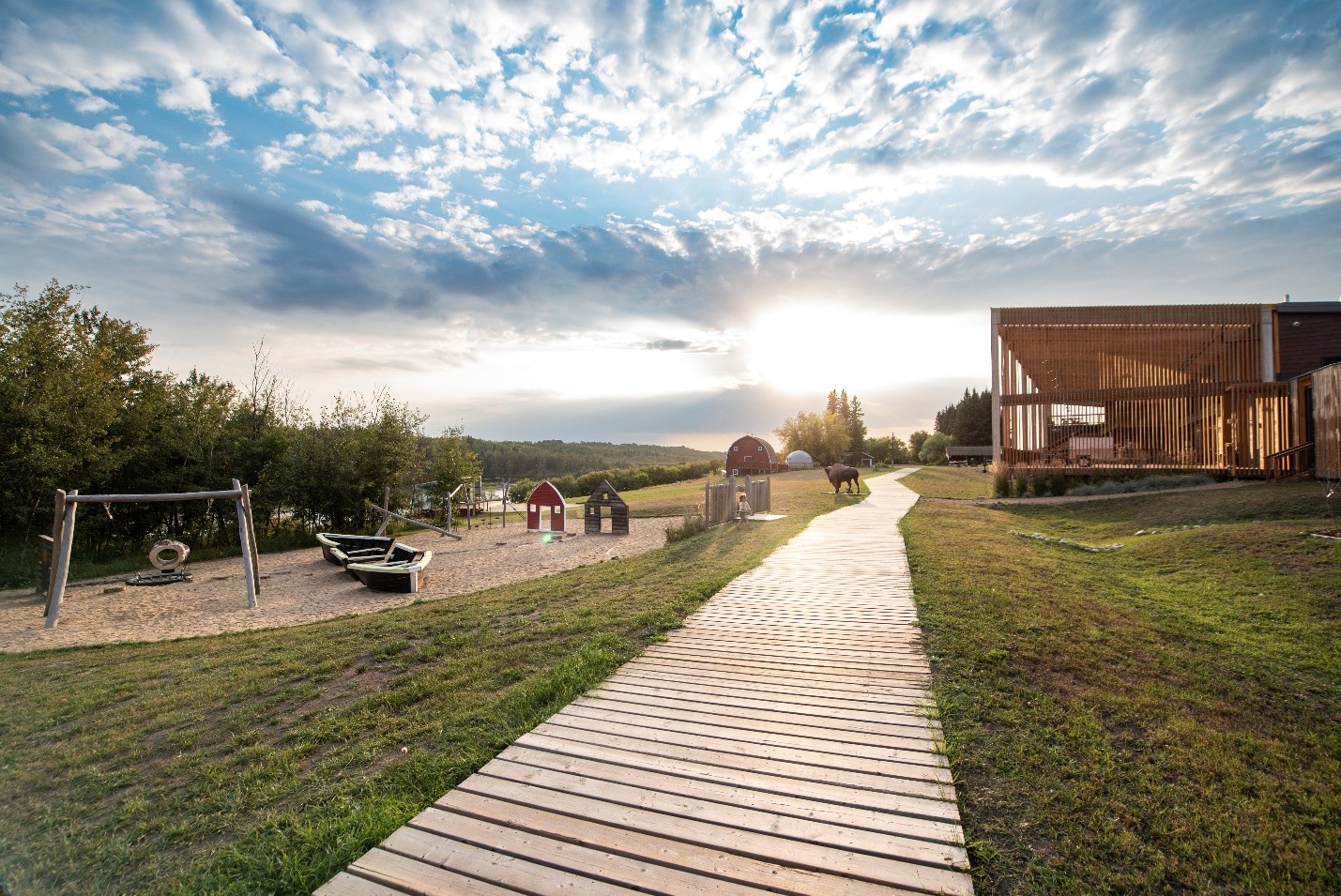
Photo courtesy of Jasmin Instagram @lemons.for.days.
Métis Crossing celebrates the culture, traditions, and history of the Métis, a post-contact Indigenous people and culture that emerged from the union of First Nations women and European (primarily French, Scottish, and English) fur traders. Métis people were essential to the fur trade, and served as guides, interpreters and negotiators for the Hudson’s Bay Company and Northwest Company, with unmatched hunting expertise. The Métis flourished along the fur trading routes, and today there are over 600,000 Métis people living in Canada.
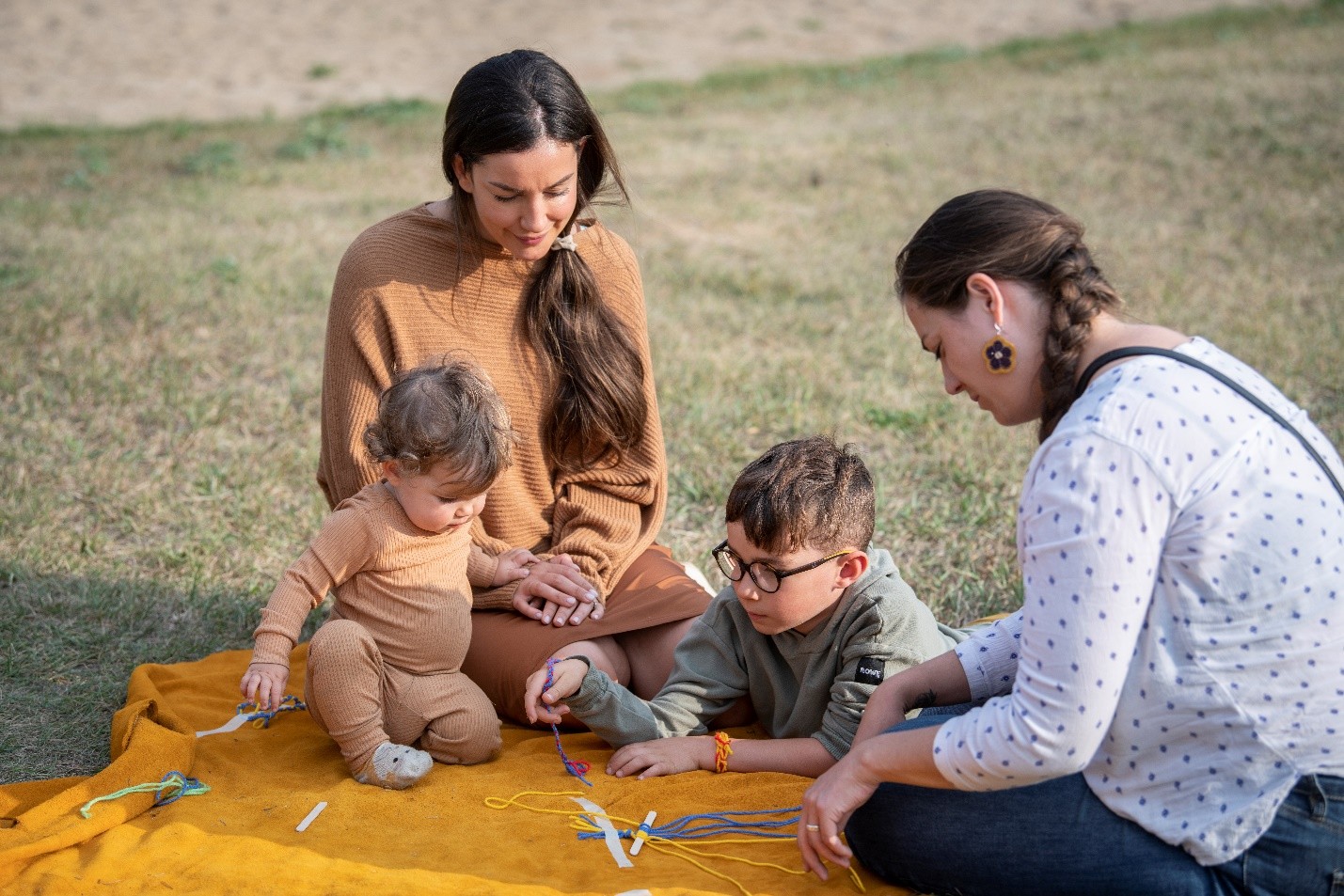
Photo courtesy of Jasmin Instagram @lemons.for.days.
The unique culture and traditions of the Métis are celebrated through programming and experiences at Métis Crossing. Signature experiences like nature walks that explore the role of native plants in Métis history and contemporary uses, a wildlife tour detailing the Métis relationship with nature as well as the significance of bison, and paddle tours of fur trade routes on the Saskatchewan River invite visitors to fully immerse themselves in Métis traditions. Plus, exhibits like Buffalo Hunt Camp offer a look into Métis buffalo hunts, traditional trappers camps, historic homes, decorative arts, and more.
Duck Lake Regional Interpretive Centre, Duck Lake, SK
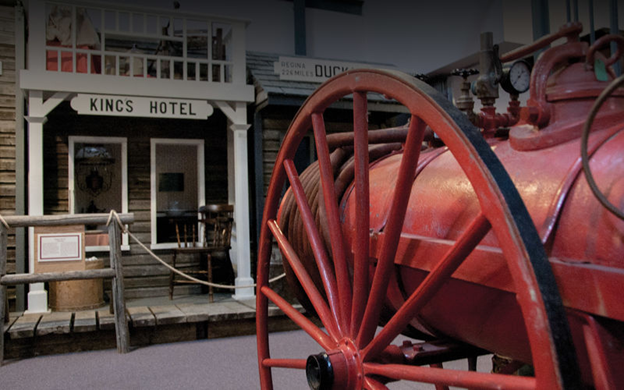
Photo courtesy of Duck Lake Regional Interpretive Centre
Duck Lake Regional Interpretive Centre invites visitors to experience a frontier society from 1870-1905. The town of Duck Lake was settled by French-speaking Métis in the 1860s and 1870s and played an important role in the fur trade. The Interpretive Centre is a testimony to the struggles faced by the settlers and the impact the near extinction of buffalo had on Willow Cree First Nation and Métis living in the area. The exhibits also include artifacts from the North-West Resistance in 1885, a conflict between Métis warriors led by Louis Riel and the Government of Canada, and an important aspect of Métis history. The museum’s 24-metre tower showcases artwork and artifacts highlighting the people of the area, and those who choose to climb to the top are rewarded with sweeping countryside views.
Learn more about the frontier and fur trade in Duck Lake, as well as the cultures and traditions that made up this settlement through guided tours, exhibitions, and education programs. More details on their website.

